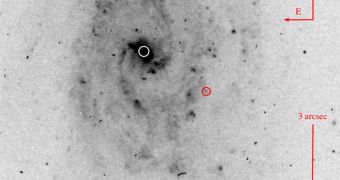While peering though some archived data collected with the NASA Chandra X-ray Observatory, a group of investigators managed to find a cosmic occurrence that other teams missed. Buried deep within the records was evidence of a giant black hole being flung out of its home galaxy, some 500 million light-years away from Earth. The distant event marks one of the rare occasions in which astronomers get to see how a supermassive black hole, of the variety usually found at the very core of impressively-large galaxies, is being thrown out of its home, Space reports.
Generally, the existence of black holes can mainly be inferred through their signatures in the X-ray portion of the electromagnetic spectrum. That is to say, the dark behemoths do not yield any measurable signs of existence on their own. However, they accumulate a lot of matter in their orbits, which organizes in a structure called the accretion disk. Due to the large number of vastly-powerful forces at work in the disk, the formation heats up considerably and then it begins releasing all manner of radiation, including X-rays.
Telescopes such as Chandra are extremely suitable for identifying these X-ray sources, but they generally find them at the very core of large galaxies. However, in this instance, the source was discovered to be located at the edge of its galaxy, which is highly unusual. A number of computer simulations the team behind the new investigation carried out demonstrate that a wide variety of reasons may have contributed to the black holes being removed from its host. One possible explanation could be that this particular one was formed from the merger of two smaller black holes.
This is one of the leading theories on supermassive black hole formation today. Many astronomers and astrophysicists believe that the largest of these structures form when two smaller bodies of the same type collide with each other, and merge. Drawing from this, some believe that the newly-discovered event may have been triggered by the angle and speed at which the two original components slammed into each other. If conditions are just right, then the resulting behemoth could be set on a course that will eventually take it out of its host galaxy. Details of the new work appear in the latest issue of the esteemed scientific journal Monthly Notices of the Royal Astronomical Society.

 14 DAY TRIAL //
14 DAY TRIAL //